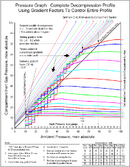7.4 Dive Analysis
The Deco Planner Analysis Display provides detailed information about tissue
pressures in all compartments for each segment of the dive.
Dive Segments
For analysis purposes any dive is broken down into segments. Each segment is
either a constant depth segment or a continuous ascent/descent segment. For
example a dive to 30m / 100ft might consist of 5 segments as follows;
A descent segment (assuming immediate descent is switched off)
A constant depth segment for the bottom time at 30m / 100ft
An ascent segment from the bottom to the 6m / 10ft stop
A constant depth segment for the deco stop
An ascent segment for the ascent from the deco stop to the surface
Ascent or Descent segment Information
The first two columns of the Analysis chart (as shown in the red rectangle) give
information about the segments as follows;
SEG:1
The segment number. Segments count from 1 upward. The
segment is either ASC or DESC for an ascent or descent
segment
START DEPTH
The starting depth for the ascent or descent
FINAL DEPTH
The final depth for the ascent or descent
RATE
The ascent or descent rate used for this segment (These
rates are set from the preferences option on the File menu)
SEG TIME
The duration of this segment in minutes
RUN TIME
The total accumulated dive time at the end of the segment
MIX 02
The percentage of Oxygen in the breathing gas during this
segment
MIX He
The percentage of Helium in the breathing gas during this
segment
[FONT=arial,sans-serif]Page 37[/FONT]
Deco Planner Manual Version 2.0.X
All Material is copyright to GUE
37
Constant Depth or Decompression stop segment Information
SEG:2
The segment number. The segment is shown as a STOP
segment
CONST DEPTH
The constant depth for this segment
PO2 ATA
The partial pressure of Oxygen at this depth (in ATA)
SEG TIME
The duration of this segment in minutes
RUN TIME
The total accumulated dive time at the end of the segment
MIX 02
The percentage of Oxygen in the breathing gas during this
segment
MIX He
The percentage of Helium in the breathing gas during this
segment
Compartment Information
The remaining columns of the analysis show information for each of the 16
theoretical tissue compartments. The column headings are from ‘Cpt 1’, (the
fastest tissue, shown in the red rectangle above) to ‘Cpt 16’, (the slowest tissue).
Each segment has 9 rows of data for each compartment as follows;
PHe
The pressure of Helium in the compartment measured in
MSW (Meters of sea water) or FSW (Feet of sea water)
PN2
The pressure of Nitrogen in the compartment measured in
MSW (Meters of sea water) or FSW (Feet of sea water)
PHe+PN2
The sum of the pressures of Helium and Nitrogen in the
compartment as given in the previous two rows
%Ambient
The percentage of the inert gas pressures in the
compartment, as compared to the ambient pressure.
[FONT=arial,sans-serif]Page 38[/FONT]
Deco Planner Manual Version 2.0.X
All Material is copyright to GUE
38
He Grad
The Helium gradient shows the difference in pressure
between the current compartment helium pressure and the
fully saturated compartment helium pressure. Once the
tissue is fully saturated this value will show zero. A positive
value means the compartment has a gradient driving the gas
into it. In other words the compartment is on-gassing. A
negative value means the compartment has a gradient
driving the gas out of it. In other words the compartment is
off-gassing
N2 Grad
The Nitrogen gradient shows the difference in pressure
between the current compartment nitrogen pressure and the
fully saturated compartment nitrogen pressure. As with the
H2 Gradient; Once the tissue is fully saturated this value will
show zero. A positive value means the compartment has a
gradient driving the gas into it. In other words the
compartment is on-gassing. A negative value means the
compartment has a gradient driving the gas out of it. In other
words the compartment is off-gassing
M-Value
The M-Value shows the maximum allowed compartment
pressure. This value is a combined value for N2 and He. To
see how close to the M-Value a compartment is, compare
this value to the PHe+PN2 row
%M-Value
This value shows the percentage of the M value reached by
the compartment. This value is calculated by comparing the
PHe+PN2 value to the M-Value. It is a measure of how close
to the M-Value the inert gas pressure is. A value of 100
would mean that the compartment pressure has reached it’s
maximum possible theoretical tolerance
%M-V Grad
This value shows how far into the decompression zone the
compartment is. The percentage is a measure of the
compartment insert gas pressure as compared with the
difference between the M-Value and the ambient pressure. A
negative value here means that the compartment pressure is
below ambient and is therefore still on-gassing. A positive
value here means that the compartment pressure is above
ambient (in the decompression zone) and is therefore off-
gassing. A value of 100 would mean that the compartment
pressure has reached it’s maximum possible theoretical
tolerance
The values in each of the compartments are compared to determine the highest
value and this value is shown in blue. This allows you to see immediately the
leading tissue compartment for each segment





